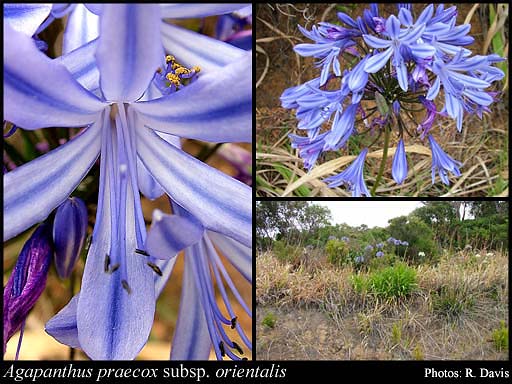- Reference
- J.S.African Bot. Suppl.4:21 (1965)
- Conservation Code
- Not threatened
- Naturalised Status
- Alien to Western Australia
- Name Status
- Current
Rhizomatous, perennial, herb. Fl. purple, Oct. Sandy loam. Lower slopes of karri/tingle forest.

Distribution
- IBRA Regions
- Jarrah Forest, Warren.
- IBRA Subregions
- Southern Jarrah Forest, Warren.
- Local Government Areas (LGAs)
- Albany, Manjimup.
Management Notes (for the Swan NRM Region)
Alternative Names. African-lily.
General Biology. Growth form. Herb. Life form. Perennial. Reproduction. Primarily seed, also rhizomes. Dispersal. Water, garden waste, wind, contaminated soil. Toxicity. The leaves, roots and sap are poisonous and irritant, and can cause mouth ulceration.
Notes. Naturalised in New Zealand, the British Isles, Canary Islands and other parts of southern Australia, where it invades forest edges, open forest and woodland. Forms dense stands which can dominate and displace groundcover vegetation, prevent regeneration of native plant species and reduce habitat for native fauna. Can change fire regimes in natural areas since plants are likely to be fire retardant, making heavily infested areas of bushland difficult to burn. Sheds old outer leaves every year, replacing them with new leaves from the apex of the growing shoot. Is one of 3 subspecies: subsp. praecox, subsp. orientalis and subsp. minimus. Subsp. orientalis originates in the eastern Cape region of South Africa and southern KwaZulu-Natal. Distinguished from subsp. praecox by its shorter perianth segments (less than 50 mm) and more leaves (up to 20 per plant) which are not leathery and have an arching habit. Species readily hybridise with each other. Survives in poor soils, but must receive some water in summer. Spreads rapidly along drainage lines, but will also gradually spread in dry areas. Numerous small seeds are produced in a 3-sided capsule toward the end of summer into autumn. Spreads gradually from underground rhizomes. These are dense, fleshy, crowded, strong and aggressive, and form large continually extending clumps. Experience in Tasmania has shown the exotic European bumblebee may be an effective pollinator of this subspecies, increasing its seed production and invasiveness.
Additional information. Origin. South Africa. History of use/introduction. Ornamental. Similar exotic species. Agapanthus praecox.
Suggested method of management and control. Small infestations can be dug out. All of the rhizome must be removed and destroyed off-site, as any remaining rhizomes will regrow even if up turned upside down. Remove small younger plants as early as possible. Cut flower heads to prevent seed set. Moderately resistant to herbicides, surfactants may help improve penetration into the waxy-coated leaves. Use cut and paint treatment. Alternatively spray with 1% Grazon® just before flowering. Try cutting leaves off to stimulate new growth then spray regrowth. Follow-up weeding of seedlings and shoots from rhizomes will be necessary. Read the manufacturers' labels and material safety data sheets before using herbicides. For further information consult the Australian Pesticides and Veterinary Medicines Authority to determine the status of permits for your situation or state.
Management Calendar
| Calendar Type | Jan | Feb | Mar | Apr | May | Jun | Jul | Aug | Sep | Oct | Nov | Dec | Comments |
|---|---|---|---|---|---|---|---|---|---|---|---|---|---|
| Active Growth | Y | Y | Y | Y | O | ||||||||
| Germination | U | U | U | ||||||||||
| Flowering | Y | Y | Y | Y | |||||||||
| Fruiting | Y | Y | Y | Y | |||||||||
| Manual Removal | Y | Y | Y | Y | Y | Y | Y | Y | Y | Y | Y | Y | |
| Herbicide Treatment | Y | Y | Y | Y | O |
Legend: Y = Yes, regularly, O = Occasionally, U = Uncertain, referred by others but not confirmed.
References
- Anon. (2010-) South Coast Weeds: Agapanthus (Agapanthus praecox ssp orientalis). Eurobodalla Shire Council URL: http://www.esc.nsw.gov.au/Weeds/Sheets/herbs/H%20Agapanthus.htm - Accessed February 2010.
- Anon. (Undated) Weeds of Blue Mountains Bushland: Agapanthus Bush invader Agapanthus praecox ssp orientalis. URL: http://www.weedsbluemountains.org.au/agapanthus.asp - Accessed February 2010.
- Brown, K. & Brooks, K. (2002) Bushland Weeds: A Practical Guide to their Management. Environmental Weeds Action Network, Greenwood.
- Hingston, A.B. (2006) Is the introduced Bumblebee (Bombus terrestris) assisting the naturalization of Agapanthus praecox spp. orientalis in Tasmania. Ecological Management & Restorations, 7 (3): 236-240.
- Hussey, B.M.J., Keighery, G.J., Dodd, J., Lloyd, S.G. & Cousens, R.D. (2007) Western Weeds. A guide to the weeds of Western Australia. 2nd Edition. The Plant Protection Society of Western Australia, Victoria Park.
- Notten, A. (2004) Plantz Africa: Agapanthus praecox Wild. Kirstenbosch National Botanical Garden URL: http://www.plantzafrica.com/plantab/agapanpraecox.htm - Accessed February 2010.
- Pacific Island Ecosystems at Risk (PIER) (2008) Weed Risk Assessment: Agapanthus praecox. URL: http://www.hear.org/pier/wra/pacific/agapanthus_praecox_htmlwra.htm - Accessed February.
- Shepherd, R.C.H. (2004) Pretty but Poisonous. Plants Poisonous to People. An llustrated Guide for Australia. R.G. and F.J. Richardson, Melbourne.
- Shire of Yarra Ranges (Undated) Agapanthus Environmental Weed Fact Sheet No. 10. URL: http://www.yarraranges.vic.gov.au/files/10_Fact_Sheet-Agapanthus.pdf.
- USDA, ARS, National Genetic Resources Program (2009) Germplasm Resources Information Network - (GRIN). National Germplasm Resources Laboratory, Beltsville, Maryland. URL: https://npgsweb.ars-grin.gov/gringlobal/taxon/taxonomysimple.aspx - Accessed October 2009.